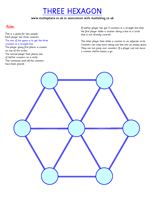 The importance of playing games with children to aid their mathematical thinking cannot be stressed too much. Playing games improves logical thinking and thinking ahead. This great little game, which I have called ‘Three Hexagon’ is a variation of ‘Three in a row’ games, played on a hexagonal board. All you need to do is print the board out, perhaps cover it with sticky back plastic to make it last longer and get two sets of 3 counters.
The importance of playing games with children to aid their mathematical thinking cannot be stressed too much. Playing games improves logical thinking and thinking ahead. This great little game, which I have called ‘Three Hexagon’ is a variation of ‘Three in a row’ games, played on a hexagonal board. All you need to do is print the board out, perhaps cover it with sticky back plastic to make it last longer and get two sets of 3 counters.
The rules are straightforward:
This is a game for two people.
Each player has three counters.
The aim of the game is to get the three counters in a straight line.
The player going first places a counter on one of the circles.
The second player then places one of his/her counters on a circle. This continues until all the counters have been placed.
If neither player has got 3 counters in a straight line then the first player slides a counter along a line to a circle that is not already covered.
The other player then slides a counter to an adjacent circle. Counters can only move along one line into an empty space. They can not jump over counters.
If a player can not move a counter she/he misses a go.
The more you play this game the more you realise that there are techniques to help with winning. Good luck!






